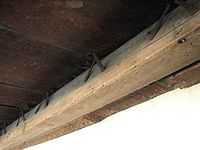Nightingale floor
 |
Daikaku-ji nightingale floor
The sound of a person walking on the "nightingale floor" of Daikaku-ji 大覚寺 in Kyoto.
|
| Problems playing this file? See media help. | |

Nightingale floors, or uguisubari (鴬張り) ![]() listen (help·info), were floors designed to make a chirping sound when walked upon. These floors were used in the hallways of some temples and palaces, the most famous example being Nijo Castle, in Kyoto, Japan. Dry boards naturally creak under pressure, but these floors were designed so that the flooring nails rubbed against a jacket or clamp, causing chirping noises. The squeaking floors were used as a security device, assuring that none could sneak through the corridors undetected. According to myth these floors were developed as a means of defense against ninja.[1]
listen (help·info), were floors designed to make a chirping sound when walked upon. These floors were used in the hallways of some temples and palaces, the most famous example being Nijo Castle, in Kyoto, Japan. Dry boards naturally creak under pressure, but these floors were designed so that the flooring nails rubbed against a jacket or clamp, causing chirping noises. The squeaking floors were used as a security device, assuring that none could sneak through the corridors undetected. According to myth these floors were developed as a means of defense against ninja.[1]
The "nightingale" in the English name refers to the Japanese Bush Warbler, or uguisu. This is a type of bushtit or nightingale native to Japan.[2]
Construction
Made from dried boards. Upside-down V-shaped joints move within the boards when pressure is applied.[3]
Etymology and translation
Kanji is one of three alphabets used in Japan. Each symbol has a specific meaning and multiple pronunciations. The term "uguisu-bari" utilizes two kanji and a single hiragana character. The first kanji (鴬) is read as uguisu and refers to the Japanese bush-warbler. Another possible kanji is [鶯] which is obsolete and not used despite being the kanji representing the specific bird.[4] The kanji for "floor" is [床] which is read yuka, but does not appear in this word. Instead the derivative kanji [張], read cho, is used in conjunction with り, the hirigana ri. Together 張り is read bari, which is the variant used in this word.[5] The meanings of these kanji individually are as follows:
- 鴬 - Japanese Nightingale
- 張 - meaning "to stretch", "to swell", "to pitch", or "to strain".
This reading means it is translated fully to "the sound of a Nightingale from the stretching/swelling/straining [of the floor]" simplified to "a floor which sounds like a Nightingale".
Examples
The following locations incorporate nightingale floors:
- Nijo Castle, Kyoto
- Chion-in, Kyoto
- Eikan-dō Zenrin-ji, Kyoto
- Daikaku-ji, Kyoto
Popular culture
- One of the novels in the Tales of the Otori series is called Across the Nightingale Floor.
- The nightingale floor features in Hokkaido level of the video game Tom Clancy's Splinter Cell: Chaos Theory, being discussed at one point by guards as protection against ninjas, and used in some floor sections.
- A nightingale floor features in the novel Rendezvous at Kamakura Inn by Marshall Browne.
- A nightingale floor is described in the James Bond novel You Only Live Twice by Ian Fleming.
- Nightingale floors are mentioned frequently in the novel Interesting Times by Terry Pratchett.
- In the 2009 film Ninja Assassin, the protagonist is trained to traverse a nightingale floor without making a sound.
Modern Influences and Related Topics
- Melody Road in Hokkaido, Wakayama, and Gunma.
- Singing Road in Anyanag, Gyeonggi South Korea.
- Civic Musical Road in Lancaster, California
External links
- Information, photos and video-clip of Nightingale floors
- Kyoto Travel: Nijo Castle
- Kansai Council page on special features in Japanese architecture (has audio clips of nightingale floors)
- Across The Nightingale Floor by Lian Hearn
Notes
References
A-Z Animals. "Uguisi" under "Animals". (2008). accessed November 3, 2012. http://a-z-animals.com/animals/uguisu/.
Bunt, Jonathan and Gillian Hall, ed. Oxford Beginner’s Japanese Dictionary. New York: Oxford University Press, 2000.
Henshall, Kenneth G. A Guide to Remembering Japanese Characters. Vermont: Tuttle Publishing Company, 1998.
Japan-guide.com. “Nijo Castle (Nihojo)” under “Kyoto Travel: Nijo Castle” (June 11, 2012). accessed November 3, 2012. http://www.japan-guide.com/e/e3918.html.
Saiga-Jp.com. “Japanese Kanji Dictionary” under “Japanese Learning” (March 7, 2012). accessed November 4, 2012. http://www.saiga-jp.com/kanji_dictionary.html.
ZenGarden.org. “Nightingale Floor, ‘Uguisu-bari’( 鴬張り )” (2012). accessed September 24, 2012. http://www.zen-garden.org/html/page_nightingalefloor.html.
| |||||||||||||||||||||||||||||||||||||
